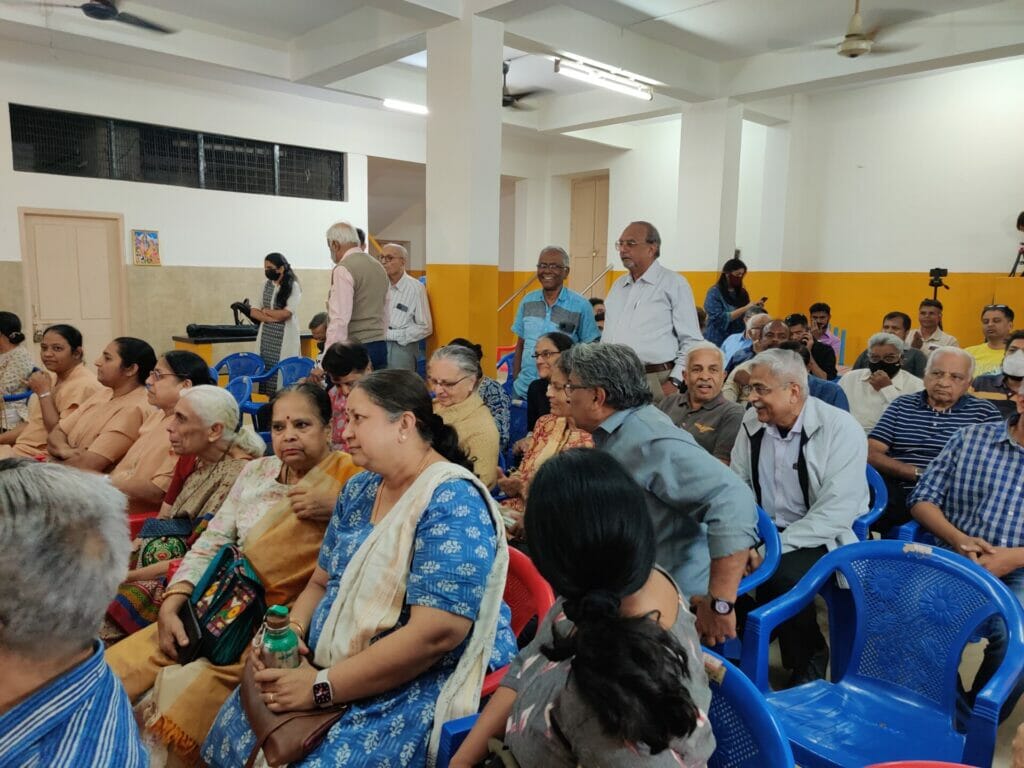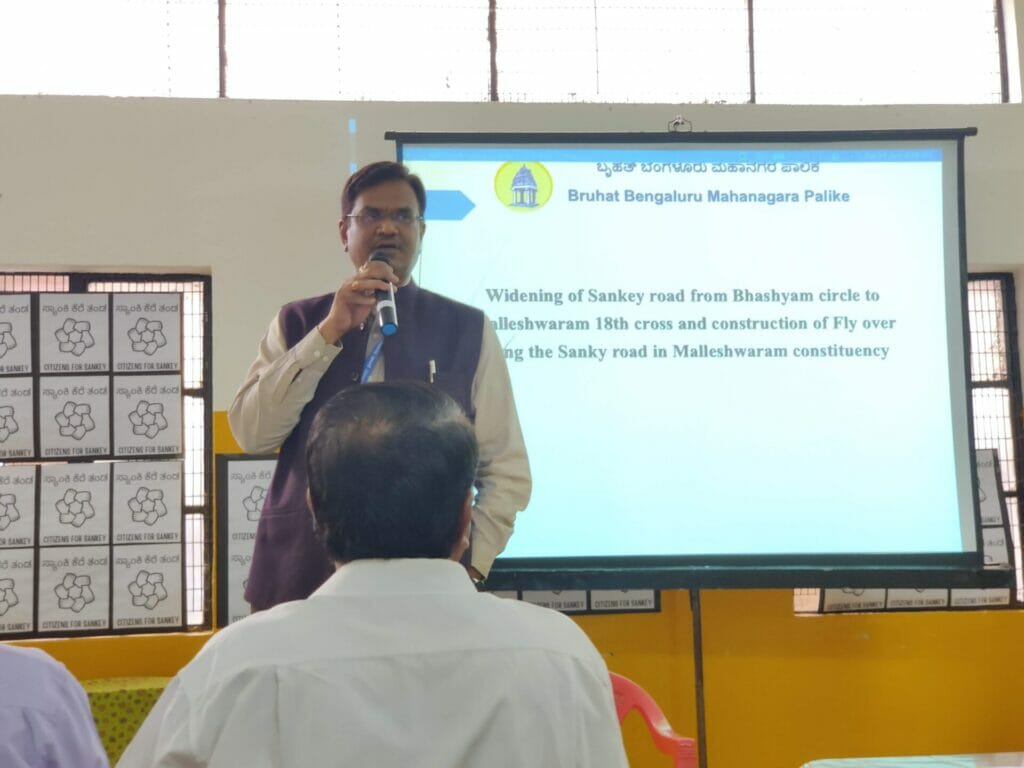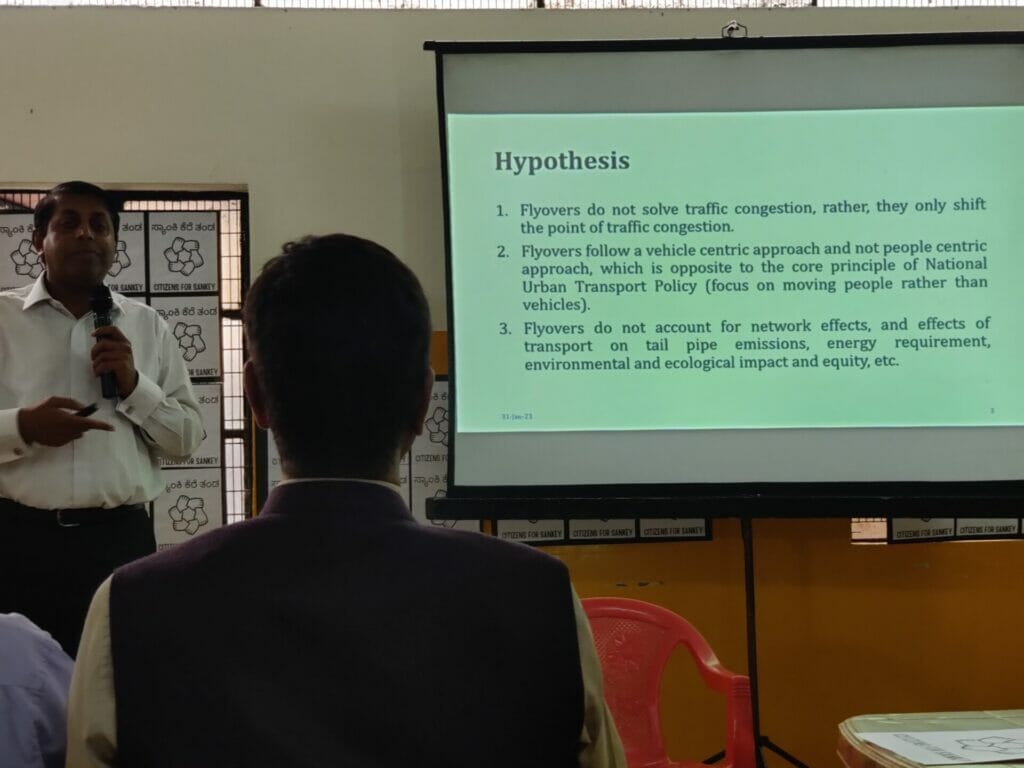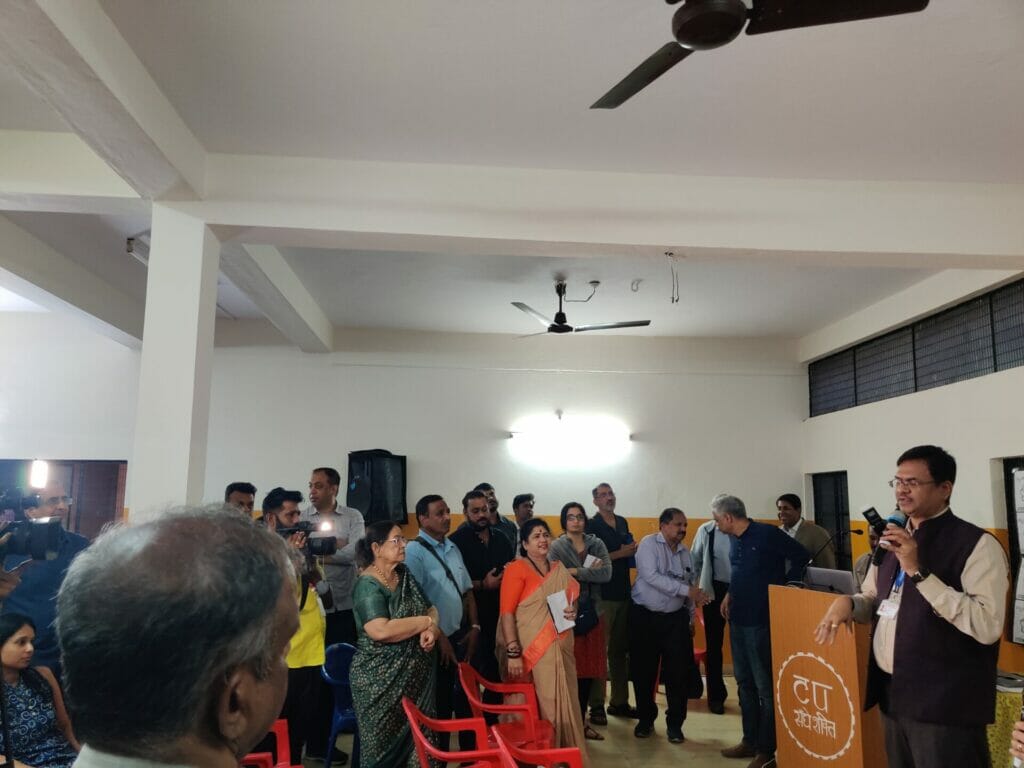On January 31st, residents in and around the Sankey Tank area organised themselves under the banner ‘Citizens for Sankey’ and gathered together for a meeting to discuss BBMP’s plan to widen the Sankey road along the Bhashyam circle to Malleshwaram 18th Cross and construct a four lane flyover.
BBMP claims that the project would ease current congestion at the Mekhri Circle junction and improve traffic flow. Residents and several civic groups have objected to the project as it would lead to felling several old-growth trees along the route, as well as cause major traffic bottlenecks during the construction process.
Close to 100 residents gathered at a packed Canara Union hall in Malleshwaram to learn more about the issues with the flyover, how traffic problems could be solved, and the larger problems with infrastructure planning in the city from a panel including IISc (Indian Institute of Science) professor Ashish Verma, who studies sustainable mobility, senior advocate Harish Narasappa, activist Shaheen Shasa of the Bus Prayanikara Vedike, and retired botany professor and journalist Ravindra Reshme.

A long term solution
The panel was joined by BBMP Chief Engineer for roads and infrastructure, BS Prahalad, who apparently volunteered to participate when he learnt of the meeting. The chief engineer assured citizens that he would explain why the flyover was required, answer their questions, and take any suggestions to the BBMP.
Prahalad reminded the citizens that Bengaluru was a growing city in terms of population and the number of vehicles on the road, and was facing major traffic issues. The major congestion along the Sankey tank has been of concern to BBMP for several years.
The chief engineer claimed that BBMP had done a detailed traffic analysis and found that traffic in this stretch was not flowing freely. He also claimed that free traffic flow was important because vehicles idling at jams contributed more to air pollution than vehicles in motion.
Read more: Study: Bengaluru’s new road-widening project will irreparably damage the environment
According to the chief engineer, BBMP did try to improve traffic along the busy Cauvery theatre junction by improving traffic signals and adding the magic box underpass, the failure of which is documented in this media report.

Prahalad said that BBMP had considered short term measures, such as adding signals and grade separators. “The number of vehicles has gone up so much that these short-term measures would not work,” he said, adding that it was important to now look at long term measures, such as flyovers.
Flyovers do not solve traffic problems
These claims were challenged by Professor Ashish Verma, who analysed the BBMP’s detailed project report (DPR) for the project. He asserted that flyovers were simply not a solution to solving Bengaluru’s traffic problems.
The sustainable transport researcher pointed out that building flyovers did not solve traffic congestion, but that they shifted the point of traffic congestion. He also said that flyovers followed a vehicle centric approach instead of a people centric approach and that flyover planning did not account for larger effects on emissions, environment, and equity.
Analysing BBMP’s DPR for Sankey road, Verma pointed out that the BBMP had skipped basic steps in urban transportation planning. He observed that while planning the flyover and road widening, BBMP did not include a clearly defined end goal for the project, alternative plans which were tested, and did not incorporate public input.

He also pointed out that BBMP’s claim that the flyover was a long term solution was based on flawed estimates of traffic growth rate in Bengaluru. While BBMP claims that Bengaluru’s vehicular traffic would grow at the rate of 5% per annum, Verma suggested that more current studies estimate growth rates of 13% or 27% per annum. This higher growth rate means that the new flyover would like saturated and congested within a year.
He further pointed out that BBMP’s plan to widen the road would increase travel time from CV Raman Road to Mekhri circle, while just optimising traffic signals at various junctions around Sankey road would lead to decrease in travel time. “Why are we wasting public money?” he asked.
Ultimately the panel was in agreement that a real long term solution could only be large scale investment in public transportation. Shaheen Shasa, founder of the civic group Bus Prayanikara Vedike, said that the city needed more buses as a way to move more people across the city.
Verma’s analysis of peak hour traffic in the city showed that cars consumed 38 times more space than buses to transport a single person. Seizing on this statistic, Shaheen pointed out that BMTC’s complete fleet of buses only numbered 6,000. “BMTC is not even running to full capacity because of the lack of staff,” she pointed out.
Read more: Traffic: The more the govt tries to change things, the more they remain the same
Instead, Shaheen recommended that the resources be spent on increasing the BMTC budget, adding more staff to the public transport corporation, and undertaking studies to identify areas of the city that needed more bus service.
Senior advocate Harish Narasappa also pointed out that the Sankey road plan was one more in a series of undemocratic planning measures undertaken by city officials who are not elected representatives. This was especially prescient as BBMP Chief Commissioner Tushar Girinath had stated that the plan would go ahead despite opposition from close to 25,000 citizens.
Not one but a series of flyovers
In the end it was Prahalad’s attempt to reassure the residents at the meeting that led to an eruption in anger and concern. When asked what the BBMP’s stance was on the loss of over 55 trees for the project, Prahalad said that BBMP was committed to sustainable development. In this case the official said the loss of trees could not be helped. He also added that the BBMP could not prevent car ownership but was attempting to discourage it by increasing parking fees across the city.

Residents also questioned BBMP’s project timeline of two years and their traffic diversion plans. When Ravindranath, a retired police officer and resident of the area, pointed out that the project would cause traffic congestion near Chowdiah Memorial Hall, Mariamma Circle and particularly to young children attending Stella Maris school. To these concerns, Prahalad simply said that traffic diversion would be addressed carefully.
However, the statement that broke the metaphorical camel’s back and caused the residents to rise in uproar came unbidden from the BBMP official itself. Prahalad said that he agreed with Verma’s point that the flyover would not solve congestion. A single flyover would not solve the issue, but a series of flyovers akin to Outer Ring Road would be needed according to Prahalad. While it was not clear if this was the BBMP’s larger plan, it was enough to cause alarm in the room.
The uproar and steady stream of questions after this forced the meeting into an early dissolution. The meeting ended with a final question by moderator Prakash Belawadi and Preeti Sunderajan from the Citizens for Sankey movement: “Will you [BBMP] rethink the project?”
Prahalad said that the project was well thought out and citizens’ concerns had been taken into account, but promised that he would take the concerns raised in the meeting to the BBMP. Residents in the room, however, were convinced that nothing would come of it. “We have to keep pressure on now,” said one participant as she walked out of the room with her fellow citizens.
No flyover
Flyover will not ease the congestion, alternative suggested should be accepted.